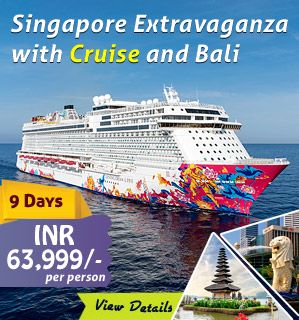Monsoons are the reason to go out and holiday after a scorching spell of the summers. July being the prime month of rains in most parts of India, brings with itself hefty opportunities, not just to enjoy the bliss of nature, but also explore the varied shades of incredible India.
These shades are depicted through different festivals, which are celebrated across boundaries of castes and community. Mentioned below is a list of some of the popular festivals in India that will certainly make your July 2016 memorable.
1. Amarnath Yatra
An experience that is bound to change the way you value any religion, Amarnath Yatra is an annual affair for lakhs of pilgrims, wishing to pay their obeisance to Lord Shiva. Since times immemorial, Amarnath cave has been a place of worship for the Hindus. Legends has it that Lord Shiva used the Amarnath cave to narrate the secrets of immortality to his consort, Goddess Parvati.
There are many epics revolving about the discovery of the cave by humans. Some say that a shepherd named Buta Malik accidentally discovered it, while others stick to the tale of Bhrigu Rishi being the founder of Amarnath shrine. Whosoever is the founder, Amarnath cave is one of the most sacred shrines for Hindus in this whole world. It is the place where pilgrims avail eternal happiness in the shadow of the almighty Shiva.
The high altitude cave shrine has an iced stalagmite Lingam, which Hindus believe to be a part of the lord. Adjacent to the Shiva Lingam, there are other two more ice Lingams, which belong to Goddess Parvati and Lord Ganesha. The sacred shrine remains snow covered for most part of the year, but during a brief period in summers, it opens its doors for the pilgrims.
Every year during the months of Shravan of the Hindu calendar (July and August), Amarnath Yatra is organized, which lasts for approx two months. The holy Amarnath cave resides at an altitude of around 12,756 ft which has to be trekked on foot. The journey is tough as it goes through undulated terrains and grounds. But with the spirit of the almighty in one’s heart, no route feels difficult. There are two routes made available from Jammu. One goes through Pahalgam, while the other is via Baltal.
In between the journey, various spiritual sites, like the Sheshnag lake, Mahaganesh mountain and Bail Gaon, all linked to the legends of Lord Shiva, will be coming your way. If you are lucky, you might catch the sight of a pair of pigeons at the doorstep of Amarnath. Some connect it to the immortal pair of birds, the description of which is mentioned in the mythological story of the shrine.
But before heading on to the spiritual journey, one must get himself registered for the Yatra, which is done by Jammu and Kashmir Government.
In Puri, it is a carnival like festival. Its that occasion, which is marked by three mammoth like chariots being pulled on the streets by devotees.
But what makes these men participate in such a huge procession? (can be tough lover for some).
Locals of Puri call it their immense devotion and love for Lord Jagannath, that drive them to celebrate in this fashion. The city, which is world renowned for the Jagannath temple, makes it a duty to completely devote itself in the celebrations of its favored deity, Lord Jagannath. And they show it the best through the Rath Yatra or Car Festival, as the foreigners would say.
It all starts on the second day of the Shukla Paksha in the 3rd month of the lunar calendar. Lord Jagannath along with his elder brother, Lord Balabhadra and sister Subhadra is worshipped in the famous Jagannath temple.
The tradition forbids some castes to enter into the temple, so for them the Rath Yatra or the Chariot journey is the only mean to seek blessings from the three Lords. The chariots start their journey from Jagannath temple and ends at Gundicha Mandir.
As per Hindu mythology, Gundicha is the place of their aunt, so after staying there for 9 days, the return trip of the chariots back to Jagannath temple takes place.
The Rath Yatra festival is amongst the most sacred festivals in India, thus, it draws pilgrims and tourists from all over the world. This year the Ratha Yatra is going to be little more auspicious than the usual.
The tradition says that after every 19 years, the idols of the deities get a new avatar, and the Rath Yatra gets named as Nabakalebar. Thus, this year it’s going to be Nabakalebar Rath Yatra which will be commencing in the second half of July 2019.
When: 14 July 2019
When: 14 July 2019
3. Karsha Gustor Festival
 |
| A Masked Dancer At The Karsha Gustor Festival |
The Gompa resides on a mountain slope in Zanskar, thus you have to climb all the way to the site. . No doubt, this Himalayan region enthralls visitors with captivating sights that look so impossible to be scheduled in the urban mundane.
From the top its like a picture perfect paradise, and with the friendlies (Lamas) in their disarming best, do not hesitate in submerging yourself in their festivity.
Ladakhis, being highly grounded to their roots, very well know how to celebrate. But certainly not like the merrymaking affairs of Goa or down south. They dance in their traditional way, narrating a story and during the Gustor, its the victory of good over evil. If you have been to any festival in Ladakh before, then watching the masked dance performances of the chums won’t be a new thing for you.
However, the festival also features a special black hat dance performance by the monks, that is highly delightful to watch. The monastery has a lot to explore and every nook and corner of it narrate a different tale.
4. Eid-Ul-Fitr
Ed-Ul-Fitr is a very popular festival for Muslims all over the world. It is an annual affair for the community and is also known as ‘Breaking of the Fast’ festival. Here fast is in context of the month long Ramadan festival, in which Muslims keep fasts and are abstained from doing any unlawful activity described by Islam.
A tough ordeal, but surely in the right faith of religion.
Coming back to Eid-Ul-Fitr. The festival depends on the sighting of the moon, and the night before it holds great significance. As a mark of celebration, Muslims go for special Eid shopping, offer prayers at mosques, invite friends and families for grand feasts.
And the feasts are just not the usual ones. If you haven’t been into one, now it’s the time. These feasts highly speak of lip-smacking Sheer Korma, which is a traditional dish, that has vermicelli, milk, sugar served with sprinkles of dates, pistachios and almonds.
Plus, it is customary for Muslim households to serve this yummy dish to whosoever turns up on their doorstep.
When: 7 June 2019
When: 7 June 2019
5. Guru Purnima
The Indian version of ‘Teacher’s Day’ of the west, Guru Purnima is a festival in honor of spiritual and academic teachers. In India, the festival is celebrated by followers of Hinduism, Jainism and Buddhism.
Hindu scholars and ascetics prefer to call it Vyas Purnima also, in a sense of gratitude to one of the most spiritual gurus of all time, Maharisi Veda Vyasa. As per Hindu traditions, the auspicious Guru Purnima festival is celebrated on a full moon day of the Ashad month i.e the months of July and August.
For the year 2016, The festival is scheduled to take place on 31st July. As the day is dedicated to the spiritual gurus, rather than modern day academic teachers, it is celebrated with austerity in the various Yogic ashrams of India.
Move to the Himalayan ashrams in Rishikesh on this day to see the colors of Guru Purnima. It is more of a worship occasion to the Guru rather than a celebration over there. However, spiritual organizations also organize cultural performances and programs especially for the day.
When: 16 July 2019
When: 16 July 2019
6. Splash
India’s answer to the water festivals of Europe and the West, Splash, is the new way to celebrate monsoons in the country. And what better way than the evergreen, monsoon host of India, Kerala, to mark this occasion. To be precise, the Splash festival in India is celebrated in the Wayanad region of Kerala.
Facts say that Wayanad, being one of the most beautiful spots in Kerala, attracts a lot of tourists. True, but now you have one more reason to travel to this part of India. The three day Splash event is a mix of both indoors as well as outdoor activities, and it will bring back your childhood days.
River rafting, crab catching, splash football, splash volleyball, paddy transplantation, treasure hunt and climbing the slippery pole are some activities that will keep you busy, even if you are a spectator.
You can also try your hand in other activities like cycling, bamboo rafting, river crossing, archery and trail walking. Splash also helps in promoting the traditional art forms of Kerala. ‘Keraleeyam’, which is an indoor program at the Splash event, showcases dance and musical performances.
Far from the mainstreams of India, lies an unexplored beauty, Arunachal Pradesh, which celebrates a festival known as the Dree festival. As the state has agriculture as its main occupation, most of its festivals are based on it.
Dree, being one of them, is celebrated in the month of July, when the state is under the spell of the monsoons. The Dree festival at the ritual level belongs to the Apatani tribe of Arunachal and involves certain sacrifices to be done in the name of the Gods.
For the rest of the population, Dree is a festival of joy where celebrations are in the form of folk music and dance competitions. The festival takes place every year in the month of July.
When: 5 July 2019
When: 5 July 2019
8. International Mango Festival, Delhi
Mango is the king of all fruits, and as the spring comes, we just can’t have enough of this pulpy fruit. But imagine a festival dedicated to this tropical delight. Yes, you heard it right! The capital of India, Delhi, every year celebrates its love for Mango with an International festival.
The Mango festival invites specialties of mangoes from all corners of the country. Be it, Alphonso, Dasheri, Falsa or Bombay green, the festival has it all. This one of a kind opportunity to relish so many flavors of the super fruit, bring mango lovers from far off distances.
Interesting fact about the International Mango Festival is, besides, sucking on the mangoes, recreational events and activities like mango eating competition, mango folk performances, mango slogan writing and mango carving are also the highlights of the festival. Mango products like Aam Papad, Aam Panna, Mango Pulp, pickles and jam are also put on sale.
So what are you waiting for?, the festival is only for two days.
When: 09 Jul 2018 to 10 Jul 2019
Where: Delhi Haat, Janak Puri, Delhi, India
When: 09 Jul 2018 to 10 Jul 2019
Where: Delhi Haat, Janak Puri, Delhi, India


















